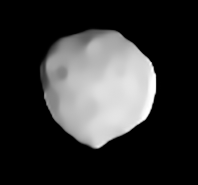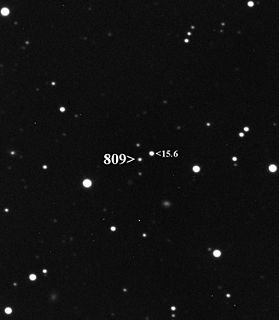R-type asteroids are moderately bright, relatively uncommon inner-belt asteroids that are spectrally intermediate between the V and A-type asteroids. The spectrum shows distinct olivine and pyroxene features at 1 and 2 micrometres, with a possibility of plagioclase. Shortwards of 0.7 μm the spectrum is very reddish.

Asteroids are minor planets, especially of the inner Solar System. Larger asteroids have also been called planetoids. These terms have historically been applied to any astronomical object orbiting the Sun that did not resemble a planet-like disc and was not observed to have characteristics of an active comet such as a tail. As minor planets in the outer Solar System were discovered they were typically found to have volatile-rich surfaces similar to comets. As a result, they were often distinguished from objects found in the main asteroid belt. In this article, the term "asteroid" refers to the minor planets of the inner Solar System including those co-orbital with Jupiter.
A V-type asteroid or Vestoid is an asteroid whose spectral type is that of 4 Vesta. Approximately 6% of main-belt asteroids are vestoids, with Vesta being by far the largest of them. They are relatively bright, and rather similar to the more common S-type asteroid, which are also made up of stony irons and ordinary chondrites, with V-types containing more pyroxene than S-types.
A-type asteroids are relatively uncommon inner-belt asteroids that have a strong, broad 1 µm olivine feature and a very reddish spectrum shortwards of 0.7 µm. They are thought to come from the completely differentiated mantle of an asteroid.
Contents
The IRAS mission has classified 4 Vesta, 246 Asporina, 349 Dembowska, 571 Dulcinea and 937 Bethgea as type R; however, the re-classification of Vesta, the V archetype, is debatable. Of these bodies, only 349 Dembowska is recognized as being type R when all wavelengths are taken into account.

The Infrared Astronomical Satellite (IRAS) was the first-ever space telescope to perform a survey of the entire night sky at infrared wavelengths.

Vesta is one of the largest objects in the asteroid belt, with a mean diameter of 525 kilometres (326 mi). It was discovered by the German astronomer Heinrich Wilhelm Olbers on 29 March 1807 and is named after Vesta, the virgin goddess of home and hearth from Roman mythology.
Asporina is a sizeable main-belt asteroid. It is classified as one of the few A-type asteroids.





